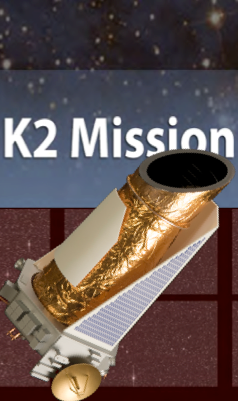 |
| Figure 1. Data was taken during Campaign 10 of the K2 mission (courtesy of the Kepler Science Center and NASA). |
An international team of astronomers using data from the rejuvenated Kepler space telescope
have discovered a rare gem: A binary system consisting of a failed star, also known as a brown dwarf, and the remnant of a dead star known as a white dwarf.
And one of the properties that makes this binary so remarkable is that the orbital period of the two objects is only 71.2 minutes. This means that
the speeds of the stars as they orbit each other are about 100 km/sec (a speed that would allow you to travel across the Atlantic in less than a minute).
Using five different ground-based telescopes across three continents, the team was able to deduce that this
binary system consists of a failed star with a mass of about 6.7% that of the Sun (equivalent to 67 Jupiter masses) and a white dwarf that has
a mass of about 40% of the sun's mass. They have also determined that the white dwarf will begin cannibalizing the brown dwarf in less than 250 million
years making this binary the shortest-period pre-cataclysmic variable ever to have been discovered.
The hot white dwarf star had originally been identified by SDSS as WD1202-024 and was thought to be an isolated star. The fact that it is actually
a member of a very close 71-minute binary
was announced by Dr. Lorne Nelson of Bishop's University at the semi-annual meeting of the American Astronomical Society in Austin, TX on June 6th
(see the link on the right for a concatenated version of the webcast of the press conference).
Dr. Saul Rappaport (M.I.T.) and Andrew Vanderburg (Harvard Smithsonian Center for Astrophysics) were analyzing the light-curves of more than 28,000 K2
targets when one observation caught their attention. Unlike the transits of exoplanets that pass in front of their host stars and cause a small attenuation
in the brightness of the star, this light curve showed reasonably deep and broad eclipses with a sinusoidal contribution to the brightness between eclipses
that is thought to be due to an illumination of the cool component by the much hotter white dwarf.

Figure 2. K2 lightcurve (black jagged curve) folded about a period of 71.23 minutes. The red curve represents a simple geometrical model
with a 5-minute long total eclipse and a 9% contribution to emulate an illumination effect on the companion star. The blue curve is the fit
to the model based on the length of the K2 observations.
The team quickly devised a model for the binary showing that it was consistent with a hot white dwarf composed of helium being eclipsed by a much cooler
and lower-mass brown dwarf companion that is seen nearly edge-on. A 3-D animation of the orbit and its lightcurve can be found at
http://physics.ubishops.ca/wd1202/anim.mp4 or by clicking on the link to the left. Notice how the hemisphere facing the hot white dwarf is highly
irradiated while the other is quite 'dark'.
But some big questions remained. As Lorne Nelson said, "We had constructed a robust model but we still had to address the 'big-picture' issues
such as how this system formed and what would be its ultimate fate." In order to address this question the team used sophisticated computer models
to simulate the formation and evolution of WD1202. According to their scenario, the primordial binary consisted of an ordinary 1.25 solar-mass
star and a brown dwarf that were in a 150 day orbit with each other. The star expanded as it aged becoming a red giant that then engulfed its
brown dwarf companion. As Nelson explains, "It is similar to an egg-beater effect. The brown dwarf spirals in towards the center of the red giant
and causes most of the mass of the red giant to be lifted off of the core and to be expelled. The result is a brown dwarf in an extraordinarily tight,
short-period orbit with the hot helium core of the giant. That core then cools and becomes the white dwarf that we observe today." According
to their calculations, the primordial binary formed about 3 billion years ago and the common envelope phase occurred relatively recently,
about 50 million years ago.
So what will happen in the future? The team believes that the emission of gravitational waves will deplete the orbital energy of the binary so that in
about 250 million years (or less), the separation between the white dwarf and brown dwarf will be so small that the brown dwarf will start to be
cannibalized by its white dwarf neighbor. When this happens, the binary will exhibit all of the characteristics of a cataclysmic variable (CV)
such as a flickering lightcurve due to accretion from a disk that surrounds the white dwarf. For this reason, the team believes that the WD1202
system can rightly be referred to as the shortest period pre-CV that has been discovered to date.

Figure 3. The final fate of WD1202 as a cataclysmic variable. The brown dwarf overflows its tear-drop-shaped Roche lobe
and loses mass to the compact white dwarf accretor An accretion disk of hot hydrogen gas surrounds the white dwarf.
This research has been submitted to the Monthly Notices of the Royal Astronomical Society as a paper entitled "WD 1202-024: The Shortest-Period
Pre-Cataclysmic Variable". The authors are: S. Rappaport, A. Vanderburg, L. Nelson, B.L. Gary, T.G. Kaye, B. Kalomeni, S.B. Howell, J.R. Thorstensen,
F.-R. Lachapelle, M. Lundy, and J. St-Antoine. The authors are grateful to Paul Schechter, Jules Halpern, Beth Christie, Cheryl Healy, David Lafreniere, Florian Maisonneuve,
Ernie Dubeau, and Wen-Jian Chung for their help and support in various forms. They also acknowledge direct financial assistance from various funding agencies such as the NSF, the
Turkish Scientific and Technical Research Council, and NSERC (Canada). Other agencies such as the South African Astronomical Observatory, NASA, Observatoire
Mont Megantic, Magellan telescopes, CFI, FQRNT, and Calcul Quebec are also thanked. A link to the paper can be found to the left.
N.B.: WD1202-024 was independently discovered by a group that includes Steven Parsons (U. Sheffield).
By mutual agreement, both discovery papers were submitted simultaneously to the Monthly
Notices of the Royal Astronomical Society (and the arXiv) in May 2017. Their conclusions
concerning the properties of WD1202 are similar to the ones presented in this press release.

Established in 1843, Bishop's University has a long and proud tradition of scholarship and education.
Recti cultus pectora roborant.
|
